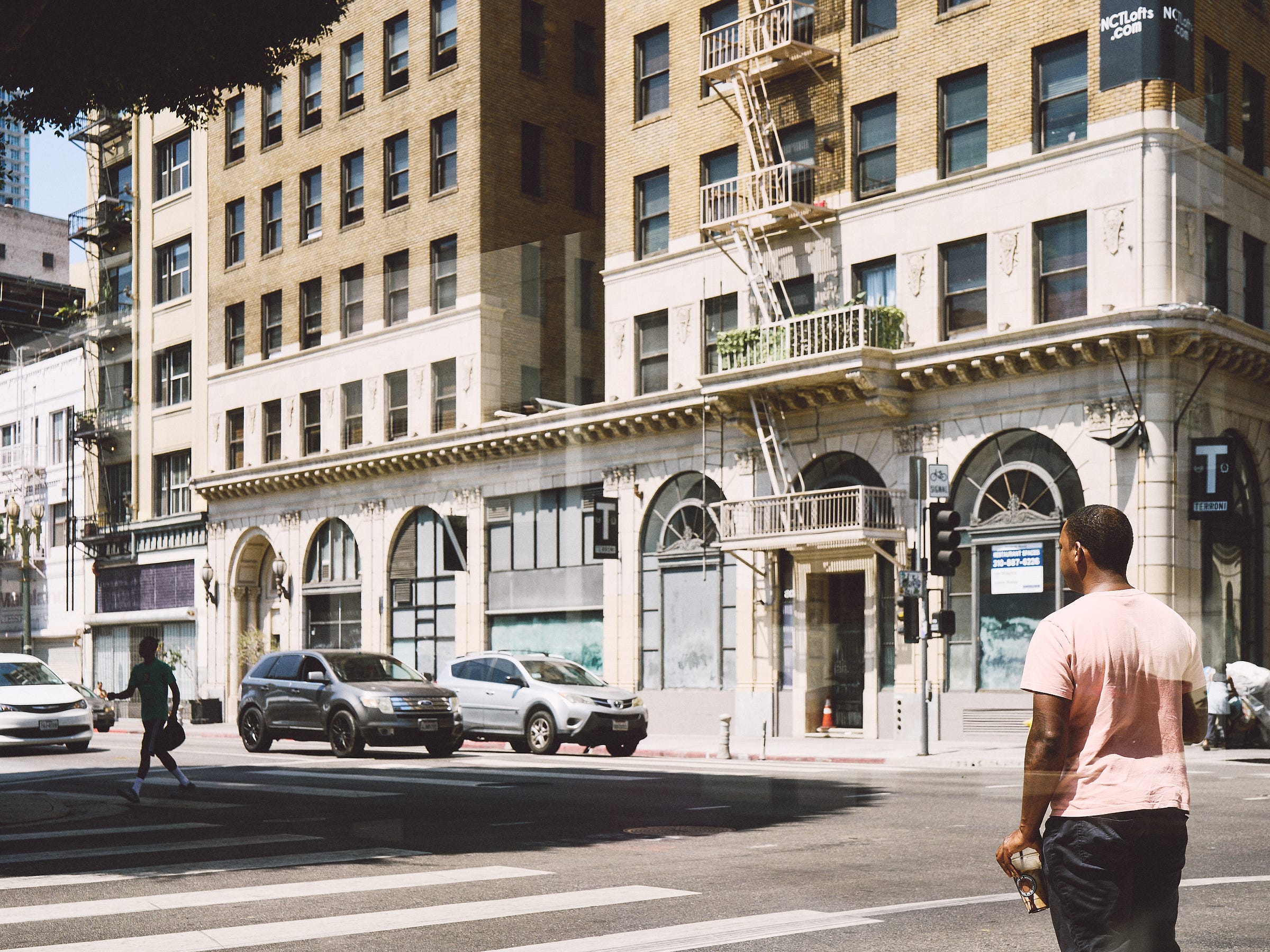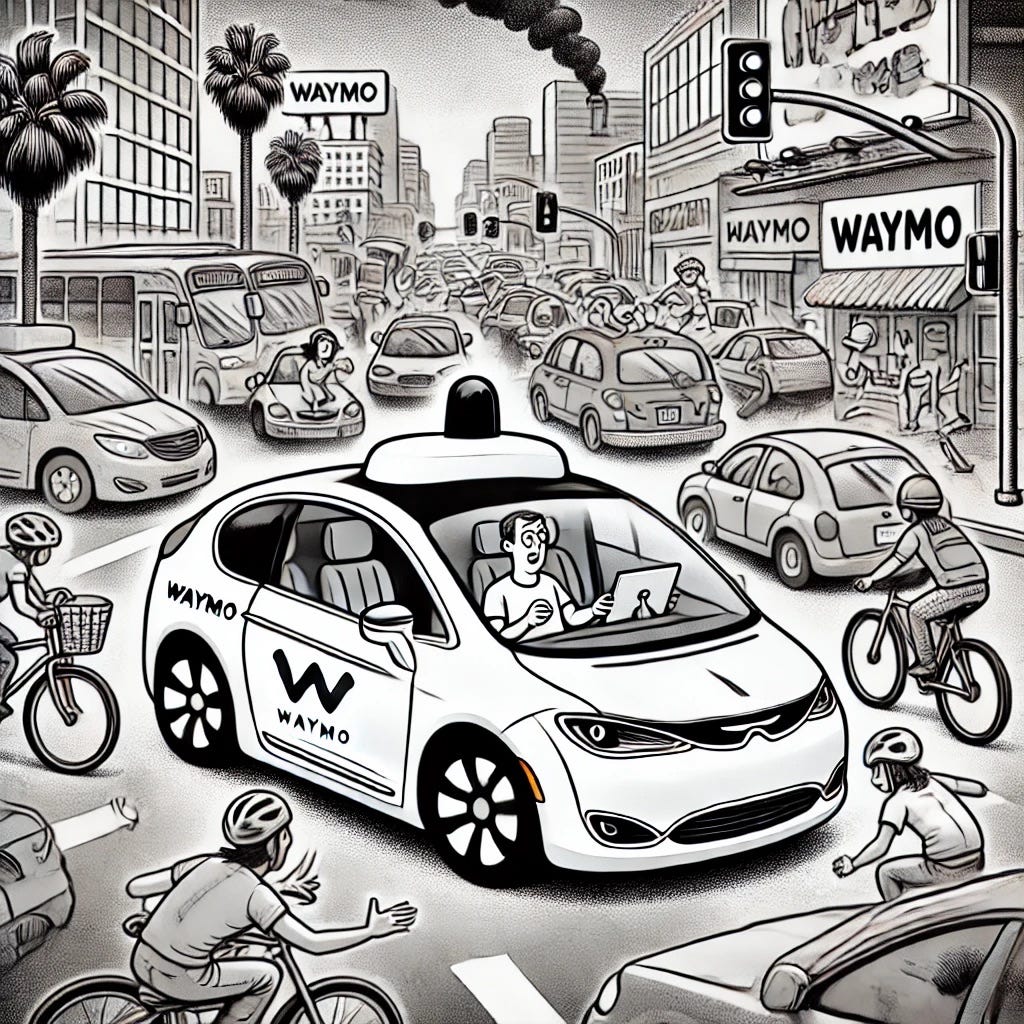Ridesharing into the Future
My initial thoughts on my first Waymo ride in Los Angeles, as well as my brain’s attempts to comprehend the technology and its implications.
Hi again,
I would first like to express my sincere gratitude to the 160 people (like you!) who follow this newsletter. You are all the coolest.
Please do not hesitate to contact me if you have any suggestions for topics you would like me to explore further in future posts.
A few weeks ago, I got the notification: I was off the Waymo waiting list in Los Angeles. For those unfamiliar, Waymo operates a fleet of self-driving cars—think of Uber or Lyft, but without the driver. The current lineup, made in partnership with Jaguar, is sleek, modern, clean, and surprisingly comfortable.
But there’s something disorienting about stepping into a car with no one behind the wheel. It’s as if you’ve fast-forwarded to a future you didn’t realize had arrived. A future that, for all its promise, still has its quirks and moments of hesitation, but it’s endlessly fascinating the whole way through.
This last Sunday morning, my boyfriend and I needed to run some errands in Downtown LA. Normally, it’s a 15-minute drive—nothing remarkable, just the standard LA shuffle. But today, Lyft’s prices were slightly higher, and Waymo was the cheaper option. Sunday morning, quieter streets—what better time to take the plunge?
Sitting inside the Waymo felt surreal. The absence of a driver triggers a brief moment of unease, but once the car pulls away, you feel its quiet confidence. The steering wheel turns smoothly, as if guided by an invisible hand, and the car hums forward. There’s a precision to it all, a sense that each move is being calculated in real time. And yet, it doesn’t take long for the reality of LA’s streets to catch up with us.
We approached a right turn, and then… nothing. The car hesitated, frozen. It could have been the parked car to our right, the dip in the road, or the unhoused man pushing his cart toward the intersection. In a city where decisions behind the wheel are made in fractions of a second, Waymo’s caution felt like a luxury LA drivers rarely afford themselves. A press of a button on the screen connected me to Waymo support, and within moments, someone had taken control, accessing the cameras, analyzing the situation, and resolving the issue. But it made me wonder—how does something like Waymo truly navigate the sprawl and unpredictability of Los Angeles? I got so curious about technology and dove deeper into its history.

A Brief History of Waymo
To understand how Waymo got to this point, it’s worth stepping back. Waymo didn’t just appear out of thin air—it has been over a decade in the making. Starting as a project under Google X in 2009, it was one of the first serious efforts to create fully autonomous vehicles. Led by Sebastian Thrun, a leader in the field of robotics and artificial intelligence, the project aimed to solve one of the most complex puzzles in modern transportation.
After years of development and successful trials—including the famous DARPA Grand Challenge, where self-driving cars navigated a difficult desert course—Google spun off Waymo as its own company around 2016. The name reflects a vision for the future: “A New Way Forward in Mobility.” Since then, Waymo has logged millions of miles of test driving, from the suburban streets of Phoenix to the dense, unpredictable roads of San Francisco, and now, the sprawling chaos of Los Angeles.
The Technology That Powers Waymo
What’s happening inside a Waymo car at any given moment is mind-boggling. The vehicle is essentially a rolling data processor, equipped with an array of sensors that work together to form a comprehensive understanding of the environment around it.
• Lidar (Light Detection and Ranging) is one of the core technologies that allows the car to create a precise 3D map of its surroundings. Newest iPhones also have Lidar sensors by the way, and it’s what allows you to create depth information in things like Portrait Mode photos. By emitting pulses of laser light and measuring how long they take to bounce back, Waymo’s system can detect the shape, size, and distance of objects, from parked cars to pedestrians.
• Radar complements the lidar system by providing the ability to detect objects at longer distances and in a wider range of weather conditions. This is crucial for maintaining safety at high speeds on freeways, especially in LA, where conditions can change quickly.
• High-definition cameras provide visual data to the car, helping it recognize more subtle cues like traffic lights, street signs, and even gestures from pedestrians.
Together, these sensors build a 360-degree, real-time map of the world around the vehicle, which is constantly being updated as the car moves. The backseat monitor even showed dogs being walked by their owners on the nearby sidewalks in real-time.
What’s beyond impressive is the decision-making process happening behind the scenes. Every second, the car is analyzing thousands of potential scenarios, predicting the behavior of other cars, cyclists, and pedestrians. Unlike human drivers, who rely on instinct and experience, Waymo’s algorithms are constantly calculating and recalculating the safest possible moves based on vast amounts of data. This includes high-definition maps that are far more detailed than anything a human driver would ever see on GPS. These maps allow the car to navigate with extreme precision, down to the exact position of lane markings and curbs.

The Challenge of LA Streets
But no matter how advanced the technology, the true test of any autonomous vehicle is how it performs in the real world. And Los Angeles is no easy test case. With its sprawling highways, erratic driving culture, and total unpredictability, LA is a constant challenge for human drivers—let alone machines.
Waymo is current waitlisted in LA, and limited to certain neighborhoods, even though it’s quickly expanding. We see lots of them already in our neighborhood in the Arts District which allowed us to start trying the service.
One of the key tensions Waymo faces is between its cautious decision-making process and the fast-paced, aggressive nature of LA traffic. At that stalled right turn, it became clear that the car was trying to make the safest decision, weighing all possibilities. It wasn’t just being slow—it was processing data, considering the risks, and prioritizing safety. But in a city like LA, especially DTLA, where drivers become impatient at the slightest hesitation, this caution can feel out of place.
Yet, this conservative approach is by design. Waymo’s system is built to prioritize safety, erring on the side of caution rather than speed. This means that in uncertain situations—like when the car was unsure whether to make that right turn—the vehicle will always wait, analyze, and ensure every movement is the safest one possible.
Learning Through Data
One of Waymo’s advantages is its ability to learn and improve over time. Each time a Waymo car encounters a new scenario, it adds that data to a shared knowledge base, allowing the entire fleet to learn from the experience. So, while the car may have hesitated at that right turn today, the next time a Waymo car encounters a similar situation, it will have a better idea of how to handle it.
This constant feedback loop is what makes Waymo such a powerful system. The company has logged over 20 million miles of driving on public roads and billions of miles in simulation. This means that every drive contributes to a broader understanding of the road—whether it’s handling freeway merging, navigating crowded downtown areas, or making sense of LA’s infamous jaywalkers.
Safety Protocols and Human Oversight
In addition to its data-driven decision-making, Waymo has robust safety protocols in place. The cars are equipped with layers of redundant systems, meaning that if one sensor fails, another can take over. And if something goes wrong—like the hesitation at the intersection—there’s always the human safety net. In my case, a remote operator from Waymo’s support team was able to intervene, taking control of the situation and resolving the issue within seconds.
You literally touch a button on your app or the backseat monitor and you are immediately connected to a human support operator.
Waymo also has built-in security features that protect passengers from outside threats. In rare instances where someone might try to jump on or break into the car (I have read some reports of this happening in San Francisco and Los Angeles), the vehicle locks down, and passengers can immediately access remote support. It’s a new kind of safety—one that blends technology and human oversight to create a more secure environment.
Ethical Considerations and the Future of Mobility
Autonomous vehicles like Waymo raise deeper ethical questions. How does the car make moral decisions in unavoidable accidents? Should it prioritize the safety of its passengers, or should it aim to minimize harm to pedestrians or other vehicles? Perhaps both? Not sure what the answers are, but it will be interesting to see how the technology progresses as more and more of these cars take over our streets.
For now, Waymo’s mission is to reduce the 94% of traffic accidents caused by human error. It’s a bold vision—a future where machines, not humans, are at the helm of the roads, following rules, avoiding risks, and ultimately making driving safer for everyone. But this transition isn’t without its challenges, and as Waymo continues to evolve, so too will the ways we interact with these machines. I do have to say our Waymo ride this last Sunday morning was extremely smooth and comfortable.
As with any new technology, Waymo’s rise has sparked significant debate—particularly around the impact on jobs. For years, rideshare services like Uber and Lyft have provided work for millions of people worldwide, from full-time drivers to those picking up extra shifts on the weekends. Autonomous vehicles, by design, eliminate the need for drivers altogether, raising concerns about the future of those jobs.
But should we be pouring resources into a system that automates a job many rely on for their livelihood? Especially in a gig economy where job security is already precarious, the potential loss of driving jobs could have ripple effects, not just for the drivers themselves but for their families and communities. This concern is particularly pressing in large cities like LA, where rideshare driving can be a flexible, relatively accessible form of employment for many, including immigrants, students, and those who might have difficulty securing traditional jobs.
I don’t think there’s an easy answer to this. While companies like Waymo promise a safer and more efficient future, there’s a trade-off—one that society has faced before with the automation of manufacturing, retail, and other industries. Advocates of automation argue that new technologies eventually create new kinds of jobs, potentially in areas like vehicle maintenance, software engineering, and customer support. However, the transition isn’t always smooth, and many worry that workers in driving professions might be left behind without proper retraining programs or safety nets in place.
But there’s another side to this story, one that resonates deeply with vulnerable groups and marginalized communities. For many people, especially minorities such as LGBTQ+ individuals like myself, women, or people of color, interacting with a rideshare driver can sometimes feel fraught with tension. Even in the best of situations, there’s often a subtle layer of discomfort—will the driver judge me based on how I look, dress, or speak? What happens if the driver makes an inappropriate comment or becomes aggressive?
A few years ago, I found myself in a rather bizarre situation while taking a cab in San Francisco. I had just completed knee surgery and was still high on painkillers, crutched, and with a knee the size of a watermelon. My only goal was to get home safely and quickly. However, for some inexplicable reason, the driver refused to drop me off at my designated street. Instead, he abruptly kicked me out in the middle of one of the busiest sidewalks in San Francisco in the Mission, just a couple of blocks away from my home. In my compromised state, I had to scramble back home on my own. This experience was a stark contrast to the seamless and reliable service I would have received from Waymo.
In recent years, there have been countless reports of harassment and assault within the rideshare industry, and these incidents disproportionately affect women and LGBTQ+ riders. The prospect of stepping into a car without a driver removes these concerns entirely. Without the human element, there’s a feeling of anonymity, privacy, and control that many riders find comforting. For some, Waymo offers not just convenience but a sense of safety that’s been lacking in traditional rideshare services. I spoke with several friends who’ve been using Waymo more regularly because of this.
For LGBTQ+ individuals, women, and other minorities who often feel vulnerable in these settings, the thought of avoiding the potential for uncomfortable interactions—or worse—can be a relief. The car’s movements are predictable, the environment controlled, and should any issue arise, support is just a button away. For some riders, this could represent a meaningful improvement in their day-to-day experience of transportation.

Balancing Innovation and Responsibility
Ultimately, Waymo’s technology forces us to ask difficult questions about the future of work and human interaction. On the one hand, the potential for increased safety and efficiency is undeniable. Autonomous vehicles remove the human unpredictability from the equation, creating safer, more controlled environments for riders. For many, especially those in vulnerable communities, this can be a game-changer.
On the other hand, the displacement of workers cannot be ignored. As we look ahead to a future where more services become automated, we’ll need to strike a balance—one that supports innovation while also considering the human cost. That could mean advocating for better protections for gig workers, investing in retraining programs, or finding new ways to integrate human elements into automated systems.
There’s no simple answer, but as Waymo continues to expand, these are the conversations we’ll need to have, both as individuals and as a society.
In the end, our ride with Waymo felt less like a seamless journey into the future and more like a glimpse at how technology and human behavior are learning to coexist. The progress is tangible, but it’s clear that both the technology and the city have more adapting to do.
We’re not there yet—but we’re getting a lot closer. I personally loved my Waymo ride, and I know there will be more coming.






